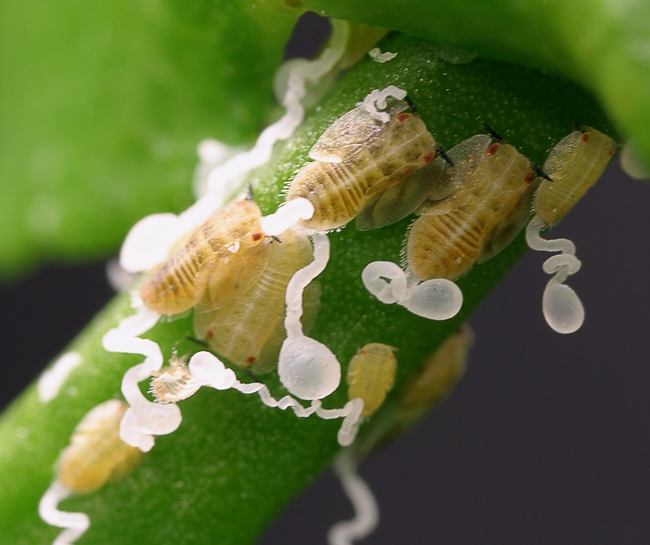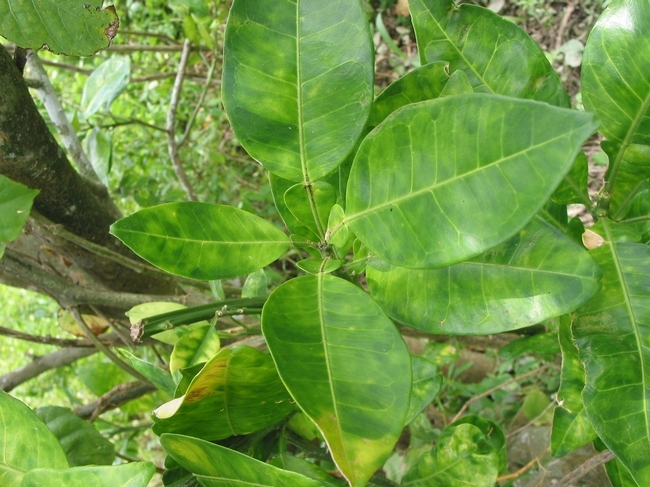Posts Tagged: acp
More wasps being released to control Asian citrus psyllid

Yesterday, the Farm Bureau of Ventura County hosted a meeting where the California Citrus Pest and Disease Prevention Committee updated the community on efforts to control the devastating citrus pest. In addition to the residential releases of the imported natural enemy of ACP – known as Tamarixia radiata – the state is also preparing to invite organic commercial producers to request releases in their groves.
“We have referred one grower in the Bardsdale area, where an ACP population unfortunately appears to have become well established,” said John Krist, chief executive officer of the Farm Bureau of Ventura County.
The research effort is led by Mark Hoddle, UC Cooperative Extension specialist in the Department of Entomology at UC Riverside. The UC Hansen Fund provided nearly $53,000 to Hoddle to fund work on biological control of ACP.
“The work Hansen funded will play a key role in the ACP suppression program throughout California, and it will become integral to the IPM program for commercial operations that Ventura County pioneered,” Krist said.
According to the LA Times article, USDA said it would set aside $1.5 million to scale up breeding and release efforts in California, Texas and Florida. An additional $125 million appropriated by Congress will be spent over the next five years to fund research into other methods to contain the spread of the disease.
"I think it's an excellent idea," Hoddle said.
The expansion will allow the California Department of Food and Agriculture to ramp up the scale of the breeding program.
Additional coverage:
Tiny 'vampire' wasps take on invasive citrus psyllid
Sanden Totten, Southern California Public Radio KPCC 89.3
Fighting Bugs with Bugs: Hatching A Solution for Troubled Trees
Steven Jackson, The Salt - What's on Your Plate, NPR
New Asian citrus psyllid website helps farmers and homeowners connect the dots
The early morning agriculture show on KMJ 580 in Fresno opened this morning with comments about UC's new Asian citrus psyllid website from Beth Grafton-Cardwell, UC Cooperative Extension specialist in the Department of Entomology at UC Riverside.
"There are a lot of websites out there relating to Asian citrus psyllid and huanglongbing disease," Grafton-Cardwell said. "What I tried to do in this one is give it a management focus with action steps: Here's where the bug and disease are, here's what you should do if you're a grower, here's what you should do if you're a homeowner. It connects the dots."
The story notes that the website includes a cost estimator for growers and homeowners that was developed by Karen Jetter, economist with the UC Agricultural Issues Center. The estimator lists effective pesticides and calculates the costs of application.
"It's a good way to figure out how you can help control Asian citrus psyllid," Grafton-Cardwell said.
The new website is at http://ucanr.edu/sites/acp.

The new Asian citrus psyllid website can be found at http://ucanr.edu/sites/acp.
New resource for growers and homeowners waging Asian citrus psyllid battle

The site’s launch coincides with the announcement last month by the California Department of Food and Agriculture that six more psyllids were found in three Tulare County yellow sticky traps. In 2012, three psyllids were found on two traps and an eradication program ensued.
The new website was developed by Beth Grafton-Cardwell and Matt Daugherty, UCCE specialists in the Department of Entomology at UC Riverside, Karen Jetter, economist with the UC Agricultural Issues Center, and Robert Johnson programmer with the UC Agriculture and Natural Resources Informatics and GIS Statewide Program program. Funding for the site was provided by UC Agriculture and Natural Resources.
The website includes information on the psyllid's distribution in California, monitoring methods and treatment options. For example, the website suggests citrus farmers and homeowners not rely on yellow stick card traps to monitor for the pest.
“At certain times of the year, the yellow sticky cards are totally unattractive to Asian citrus psyllid,” Grafton-Cardwell said. “The cards are just color, but citrus flush is an attractive color and also emits irresistible volatiles or smells.”
The website advises farmers to regularly conduct systematic visual surveys along the margins of their orchards looking carefully at new green shoots and conducting tap sampling. To tap sample, spray a plastic surface with soapy water, position the plastic sheet underneath a branch and tap the branch above to dislodge adult ACP. The insects will stick to the filmy plastic where they can be studied with a magnifying hand lens to determine if they are psyllids.
If psyllids are found, the UC website outlines the immediate action that is required.
Adult psyllids should be placed in a container with 90 percent alcohol and reported to the county agricultural commissioner’s office so the insects can be tested for huanglongbing disease. Immature stages of the pest should be left on the tree so the ag commissioner’s office can make an official regulatory collection.

“Florida and Texas don’t have exactly the same insecticides that are available in California and the environmental conditions are different,” Grafton-Cardwell said. “Over time we will compare different treatments and determine how long they will protect the trees. Any new developments will be posted to the website.”
Because the goal in the San Joaquin Valley is eradication, Grafton-Cardwell recommends aggressive action against a psyllid infestation.
“The best approach is using two broad-spectrum insecticides within a short period of time,” she said. “No one insecticide will kill all the stages of the pest."
Another key to successful eradication is area-wide treatment coordination. Grafton-Cardwell suggests farmers work closely with their treatment liaisons and treat their orchards in a coordinated manner.
“The bigger the area being sprayed at the same time, the better,” Grafton Cardwell said. “If we get a blanket effect over the whole area, that’s been shown in Florida and Texas to have the greatest impact on the psyllid populations.”
The aggressive psyllid treatment aims to buy time for researchers to find long-term strategies for maintaining the California citrus industry in the presence of ACP and, especially, with the incurable and fatal citrus disease they spread, huanglongbing.
Newly found Asian citrus psyllids prompt quick action in Tulare

The July ACP find prompted the California Department of Food and Agriculture to quarantine 178 square miles in the Porterville area, placing severe restrictions on the movement of local citrus nursery stock and citrus fruit outside the area. It also prompted several hundred farmers and pest control advisers to gather July 30 at the International Agri-Center in Tulare for an update on the threat.
Like a scene from the film “Scared Straight,” Ken Keck, former executive director of the Florida Department of Citrus and now director of the California Citrus Research Board, admonished the California farmers to learn from the Sunshine State’s mistakes.
“I feel like the ex-con in front of a room of 17-year-olds,” Keck said. “All I can say is, ‘prevent, prevent, prevent.’”
Asian citrus psyllid is established in Southern California. Efforts in the southern part of the state are focused on managing the psyllids to reduce the likelihood they will find a tree infected with huanglongbing. Huanglongbing (HLB) is an incurable and fatal disease of citrus spread by ACP.
By working together and following science-based treatment strategies, UC Cooperative Extension specialist Beth Grafton-Cardwell believes farmers and CDFA can still eliminate ACP in the San Joaquin Valley, where the bulk of the state’s commercial citrus is grown.
At the Tulare meeting, Grafton-Cardwell explained the eradication strategy she developed by studying Asian citrus psyllid and huanglongbing disease management programs in Florida and Texas, another state where the pest is well established.
“We want to slow the spread of psyllid into new areas,” Grafton-Cardwell said. “We want to prevent psyllids from finding HLB infected trees.”
Although it is unlikely the pest and disease can be kept at bay indefinitely, Grafton-Cardwell said the battle will buy time for researchers to discover long-term approaches for maintaining California’s citrus industry in the presence of ACP and HLB.
Developing citrus varieties resistant to HLB through traditional breeding or genetic modification will take too long, she said. Scientists are considering such futuristic solutions as inserting HLB resistance into a mild form of the Tristeza virus and inoculating trees with the virus to fight HLB.
“Everyone is racing to come up with tactics to fight ACP and HLB,” she said. “I believe we will eventually be using multiple approaches, such as a repellent spray to keep ACP off the trees and perhaps breeding ACP that can’t transmit HLB and then flooding the population with these incapacitated psyllids.”
To fight ACP and HLB, growers and homeowners can access detailed information on the pest’s distribution, monitoring methods and treatment options on a new website created by Grafton-Cardwell with funding from UC Agriculture and Natural Resources.
|
For tap sampling, spray a plastic surface with |
The website advises farmers and homeowners to regularly conduct visual surveys and tap sampling (see video on right) in their orchards. “Yellow sticky card traps are not very attractive to psyllids,” it says.
If psyllids are found, immediate action is required.
Adult psyllids should be placed in a container with 90% alcohol and reported to the county agricultural commissioner’s office so the insect can be tested for HLB. Immature stages of the pest should be left on the tree so the ag commissioner’s office can make an official regulatory collection.
An ACP find should also trigger rapid and wide treatment with the most effective pesticides possible.
Micronutrient deficiency can look like HLB infection

Neil O’Connell, UC Cooperative Extension advisor in Tulare County, a citrus expert, recommends that field staff also be well versed on these issues since they are in the field daily during the citrus harvest.
Huanglongbing, a disease spread by Asian citrus psyllid, is the worst citrus disease in the world. The disease was detected on one tree in Southern California in March, the first such find in the state. Officials are asking for farmers and home gardeners to be on the look-out for other HLB-infected trees.
O'Connell says deficiencies of zinc, iron and manganese can resemble leaf symptoms found in trees with HLB.
"Some deficiencies have fairly similar symptoms," O'Connell said. "If you are very familiar with deficiency patterns in these elements then it is much easier to separate this out. You can recognize whether the problem is zinc, iron, manganese, or another deficiency while possibly ruling out HLB."
A distinguishing characteristic of HLB infection is a yellow area that crosses from one interveinal area to another, O'Connell explained.